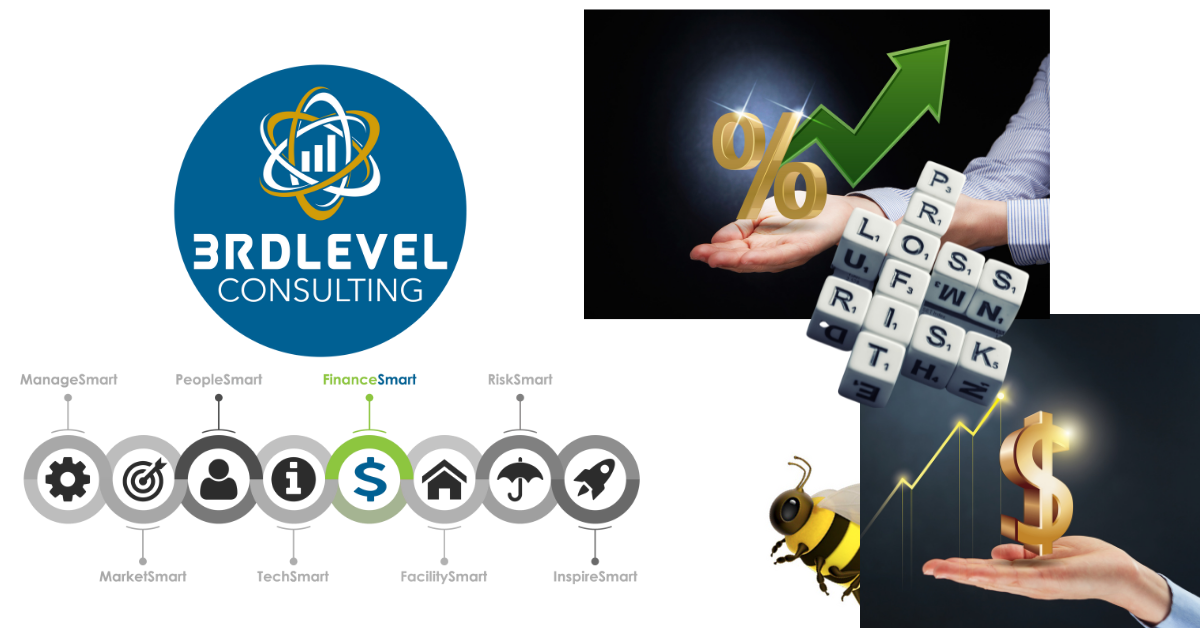We hope you have enjoyed our Business Finance series. If you are catching this blog and you haven’t yet read our first two blogs in the FinanceSmart series, we recommend heading back to Business Finance 101 – What Every Owner Must Know to check out that article as this one is going to build on and expand into a significant amount of detail with that blog as the foundation. You may also want to check our other blog in the series, Tax Planning, Prep and Projections. Reading over those two, is a great warm up for this one!
Part 1: “THE RANGES”
The Basics of Managing by Percentages – Staying in the Safe Zone and Out of the Danger Zone
As we mentioned in Tax Planning, Prep and Projections, managing by percentages and ratios frees us from the deceptions of merely measuring gross revenues or gross dollar increases in various time periods. Managing by dollar targets is a sure way to grow programs without proper regard for the overall picture!
If all you are trying to do is to grow the top line revenues, how do you know if you are truly generating more profit?
Company leaders including, both Owners and Program Directors need to be aware that while the company may have some OVERALL percentage targets, each individual program may have variations that differ significantly from the company’s overall percentages.
Some examples are:
- Preschool Gymnastics may have a total Payroll percentage of only 35%, while Competitive Gymnastics may have a total Payroll percentage exceeding 60%. Why?
- Day Camps may have a total Payroll percentage of up to 45%, but still be more profitable than programs with a total Payroll percentage of only 35%. Why?
- Entertainment Programs (i.e., Birthday Parties and Special Events) may have total Payroll percentage of only 35%, yet may still be only borderline profitable. Why?
There are many ways that the above scenarios could play out. The “why’s” above could be attributed to:
- Competitive Gymnastics takes more space, needs more expensive equipment, and demands more time from the athletes. Therefore, the hourly rates that these athletes pay is far lower, additionally the hourly pay of the competitive coaches due to their experience and training is typically significantly higher than the hourly pay of the preschool coaches (especially if you factor in the administrative wage most team coaches receive) and therefore the payroll percentage is bound to be h
- Day Camps may have supervision rates of up to 12:1, enabling that program to “make it up on volume” with respect to profits. The specific activities involved may allow for the use of Junior Staff for segments such as arts & crafts while the supervisory staff is working in a different program and not involved for all hours of the camp which contributes to profitability. If the supervisor is required for the event, that person’s pay may be allocated to camp while they are in a dual-role.
- Entertainment programs may have costly supplies, prep time, cleaning time, incentive staff pay rate and advertising budgets, thus eroding profitability.
These are just samples; you can probably think of many more! In any case, “Managing by Percentages” will allow you to do the financial “detective work” that is so necessary to understanding your financial health and ultimately to business success!
Starting with 100% of income work through expected percent for each expense to arrive at your projected net income or loss. For example, Payroll and Payroll Taxes may range from the low-end of 30% of your total expenses to upwards of 60% with a model or average of 45%. Another area with a significant range of 6 to 30% may be your rent. Marketing may range from 1 to 4% with most being around 2%. This analysis should be completed for all expense categories by department where possible. Our webinar will go through this in greater detail and if you would like a personal review of your finances versus Industry Ranges, contact us to set up a consultation.
Part 2: “THE PROFITABILITY STORY”
Knowing your REAL Financial Health via Statements and Profitability Factors
In Business Finance 101 – What Every Owner Must Know we discussed the importance of not relying solely on one report to tell your financial story. Jump back over to Business Finance 101 if you want to do a quick refresher on reports and statements.
Examining every line item on your Profit and Loss (Income) Statement at minimum, annually will always pay big dividends. Remember that suppliers of products and services can change their suppliers, as they are also always searching for a way to be more profitable too. It never hurts to ask for a better deal (purchasing earlier in the year, purchasing in volume, guaranteeing a certain amount of business during the year, etc.) Big ticket items such as; insurance, loans, supplies, contracts should be shopped periodically amongst 2-3 vendors.
Although Key Profitability factors work together, the dollar ($) or percentage (%) improvements in each of the categories shown below will vary with each business and/or site.
- BUSINESS MODEL: Conduct annual reviews to determine if your current choices for business model/structure (LLC, S-Corp, Partnership, etc.) will set up for maximizing profit potential.
- FACILITY DESIGN: Review available space to optimize allocation and productivity of each square foot available. Our Maximizing Capacity for Optimum Revenue can assist if you are considering remodeling or reallocating space. A good question to ask yourself is: “Do we have all of the teaching and learning stations possible in this facility?”.
- MORTGAGE or RENT: Just because your business has a set mortgage or rental time period, understand that even these fixed expenses may be negotiable. 3rd Level can help you negotiate. Check Mortgage Consultants if you would like to discuss your options.
- PAYROLL: In most service businesses, payroll is the #1 expense. Base pay is often much higher needed because businesses aren’t taking full advantage of incentive systems. A Base Plus Incentive (bonus, profit-sharing, etc.) system will keep everyone striving forward, on the same page, and on the same side of the table.
- PRICING: Pricing is elastic! A little-known fact is customers are waiting for you to set the “value proposition”. They will never believe that your service or product is “worth the price” until you do. Once you have determined the price, based on the value of the total package of benefits that you will deliver, then (and only then) can you present it to the customer. Do not be afraid to be the price leader in your local market area.
- CLASS RATIOS: Flexible class ratios with a range of students per teacher are recommended over rigid or fixed ratios. Publishing ratios in a range of 7-9 students or 8-10 students to 1 teacher allows your business more flexibility for scheduling make up classes, last minute student additions, etc. Note that ratios due to COVID restrictions have changed for many industries.
- DEVELOP MORE PROGRAMS FOR THE SAME CLIENTELE: Adding programs to provide more services and/or products to the same customers is one of the easiest ways to improve profitability. Check out this Maximizing Capacity for Optimum Revenue for ideas. Customers that already know and trust our company and people will buy more if given the incentives to do so. In addition, the more (integrated and reasonable) programs we add to your “mix”, the more revenue per square foot you generate, improving your facilities investment ROI. While you may not automatically generate more profit, capacity maximization gives you a great chance to do so.
Remember, understanding the factors that influence your ability to be profitable is crucial. Ultimately, using your knowledge of the finances will allow for you to run your business in alignment with your culture and values.
Using your knowledge to make accurate projections becomes invaluable in making budget decisions, planning financing and planning for eventual retirement!
Part 3: “THE END GAME”
Using Parts 1 and 2 to Prepare You for Successful Expansion, Sale or Acquisition
Using our database of over 350 valuations and over 150 completed transactions, we can show you the trends by the numbers, regardless of geographical location. As an owner strive for higher discretionary earnings (DE) and a lower CAP Rate.
The term “CAP/Risk Rates” refers to the CAPitalized rate of return that an educated investor would require as a return on their monetary investment. This CAP Rate is determined by a series of Risk Criteria that yields a “risk score” that translates into a formula for the Rate of Return in each specific case. Our 3rd Level Valuation & Business Brokerage team can help you lower your CAP/Risk Rate. CLICK HERE to schedule a free confidential consultation.
The Businesses with lower CAP/Risk Rates generally
- sell faster
- sell for greater % of Gross Revenue (GR)
- get financed easier
- have a smaller Seller Note
- have more structure flexibility for the Owners
Businesses with higher Owner DE (Discretionary Earnings) are definitely worth more, because of the multiplier effects of various valuation methods. So, the axiom “Pay Yourself First” has positive effects both now and in the future!
The Goal Ratio of Discretionary Earnings to Gross Revenues is 12% – 20% for Financing
Trends Beyond the Numbers
- More square footage does not necessarily equate to increased Profitability
- Program diversity does not necessarily equate to increased Profitability, although it does even out the matrix of income streams throughout the calendar year
- Professional operations may not necessarily contribute to greatly increased profitability, but it definitely makes life easier for the current owner and for transitioning to a new owner.
Summing It All Up
The Keys to Profitability are:
- Location!
- Relatively low occupancy costs
- A Business Model chosen by design, not by chance!
- Medium-High to High Tuition Fees
- Full Classes
- Variable Compensation for Key Staff
- Tech up! Technology that helps you work smarter not harder.
- Solid leadership team and professional mentors.
But, in the long run it is all about balance. Balancing your financial health with your culture, values and goals is a win on all levels. Profit on paper doesn’t always equal happiness or longevity. Connect with us help you chart your path to success.
Meet The Contributors
The contributors have successfully served children’s activity centers, gymnastics gyms, dance studios, cheer gyms and swim schools worldwide for 35+ years.



